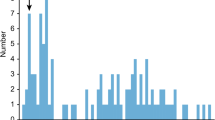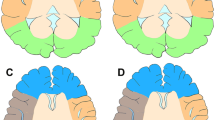Abstract
Background
The object of this study was to compare the long-term outcomes in adult patients with moyamoya disease (MMD) with posterior circulation involvement (PCi) treated through surgical revascularization with those in adult patients without PCi.
Methods
The records of 32 consecutive adult patients with ischemic-type MMD who were treated with revascularization were reviewed. Twelve of these patients (38 %) had PCi at initial onset. Clinical characteristics of the patients with PCi were compared to those without PCi. Neurological outcomes were assessed using the modified Rankin Scale (mRS) in the preoperative and postoperative follow-up periods. A five-year Kaplan-Meier stroke risk was calculated.
Results
The frequency of presenting with infarction was significantly higher among patients with PCi than among those without PCi (p = 0.006). mRS scores in the preoperative period were significantly higher in patients with PCi than in patients without PCi (p = 0.0004). There were no significant differences in mRS scores between the preoperative and postoperative follow-up period in patients with PCi (p = 0.3), nor were there any between the preoperative and postoperative follow-up periods in patients without PCi (p = 0.2). The five-year Kaplan-Meier risk of surgical morbidity and ipsilateral stroke was 14.3 % in surgically treated hemispheres with PCi versus 14.9 % in surgically treated hemispheres without PCi (p = 0.96).
Conclusions
PCi at initial onset was significantly correlated with poor outcome. Revascularization for the middle cerebral artery territory in patients with PCi was effective at preventing recurrent ischemic stroke.




Similar content being viewed by others
References
Fukui M (1997) Guidelines for the diagnosis and treatment of spontaneous occlusion of the circle of Willis (‘moyamoya’ disease). Clin Neurol Neurosurg 99:S238–S240
Hallemeier CL, Rich KM, Grubb RL, Chicoine MR, Moran CJ, Cross DW III, Zipfel GJ, Dacey RJ, Derdeyn CP Jr (2006) Clinical features and outcome in North American adults with moyamoya phenomenon. Stroke 37:1490–1496
Hishikawa T, Tokunaga K, Sugiu K, Date I (2013) Clinical and radiographic features of moyamoya disease in patients with both cerebral ischaemia and haemorhage. Br J Neurosurg 27:198–201
Hishikawa T, Tokunaga K, Sugiu K, Date I (2013) Assessment of the difference in posterior circulation involvement between pediatric and adult patients with moyamoya disease. J Neurosurg 119:961–965
Horiuchi T, Kusano Y, Asanuma M, Hongo K (2012) Posterior auricular artery–middle cerebral artery bypass for additional surgery of moyamoya disease. Acta Neurochir 154:455–456
Kinugasa K, Mandai S, Kamata I, Sugiu K, Ohmoto T (1993) Surgical treatment of moyamoya disease: Operative technique for encephalo-duro-arterio-myo-synangiosis, its follow-up, clinical results, and angiograms. Neurosurgery 32:527–531
Kinugasa K, Mandai S, Tokunaga K, Kamata I, Sugiu K, Handa A, Ohmoto T (1994) Ribbon encephalo-duro-arterio-myo-synangiosis for moyamoya disease. Surg Neurol 41:455–461
Kuroda S, Hashimoto N, Yoshimoto T, Iwasaki Y (2007) Research committee on moyamoya disease in Japan: Radiological findings, clinical course, and outcome in asymptomatic moyamoya disease: results of multicenter survey in Japan. Stroke 38:1430–1435
Lee JY, Kim SK, Cheon JE, Choi JW, Phi JH, Kim IO, Cho BK, Wang KC (2013) Posterior cerebral artery involvement in moyamoya disease: initial infarction and angle between PCA and basilar artery. Child’s Nerv Syst 29:2263–2269
Liu W, Morito D, Takashima S, Mineharu Y, Kobayashi H, Hitomi T, Hashikata H, Matsuura N, Yamazaki S, Toyoda A, Kikuta K, Takagi Y, Harada KH, Fujiyama A, Herzig R, Krischek B, Zou L, Kim JE, Kitakaze M, Miyamoto S, Nagata K, Hashimoto N, Koizumi A (2011) Identification of RNF213 as a susceptibility gene for moyamoya disease and its possible role in vascular development. PLoS One 6:e22542
Miyamoto S, Kikuchi H, Kawasawa J, Nagata I, Yamazoe N, Akiyama Y (1988) Pitfalls in the surgical treatment of moyamoya disease. Operative techniques for refractory cases. J Neurosurg 68:537–543
Miyamoto S, Kikuchi H, Karasawa J, Nagata I, Ikota T, Takeuchi S (1984) Study of the posterior circulation in moyamoya disease. Clinical and neuroradiological evaluation. J Neurosurg 61:1032–1037
Miyatake S, Miyake N, Touho H, Nishimura-Tadaki A, Kondo Y, Okada I, Tsurusaki Y, Doi H, Sasaki H, Saitsu H, Shimojima K, Yamamoto T, Higurashi M, Kawahara N, Kawauchi H, Nagasaka K, Okamoto N, Mori T, Koyano S, Kuroiwa Y, Taguri M, Morita S, Matsubara Y, Kure S, Matsumoto N (2012) Homozygous c. 14576G > A variant of RNF213 predicts early-onset and severe form of moyamoya disease. Neurology 78:803–810
Mugikura S, Takahashi S, Higano S, Shirane R, Kurihara N, Furuta S, Ezura M, Takahashi A (1999) The relationship between cerebral infarction and angiographic characteristics in childhood moyamoya disease. Am J Neuroradiol 20:336–343
Mugikura S, Takahashi S, Higano S, Shirane R, Sakurai Y, Yamada S (2002) Predominant involvement of ipsilateral anterior and posterior circulations in moyamoya disease. Stroke 33:1497–1500
Mugikura S, Higano S, Shirane R, Fujimura M, Shimanuki Y, Takahashi S (2011) Posterior circulation and high prevalence of ischemic stroke among young pediatric patients with moyamoya disease: Evidence of angiography-based differences by age at diagnosis. Am J Neuroradiol 32:192–198
Nakagawara J, Osato T, Kamiyama K, Honjo K, Sugio H, Fumoto K, Murahashi T, Takada H, Watanabe T, Nakamura H (2012) Diagnostic imaging of higher brain dysfunction in patients with adult moyamoya disease using statistical imaging analysis for [123I] Iomazenil single photon emission computed tomography. Neurol Med Chir (Tokyo) 52:318–326
Nakashima H, Meguro T, Kawada S, Hirotsune N, Ohmoto T (1997) Long-term results of surgically treated moyamoya disease. Clin Neurol Neurosurg 99:S156–S161
Pandey P, Steinberg GK (2011) Outcome of repeat revascularization surgery for moyamoya disease after an unsuccessful indirect revascularization. J Neurosurg 115:328–336
Rankin J (1957) Cerebral vascular accidents in patients over the age of 60. III. Diagnosis and treatment. Scott Med J 2:254–268
Starke RM, Komotar RJ, Hickman ZL, Paz YE, Pugliese AG, Otten ML, Garrett MC, Elkind MSV, Marshall RS, Festa JR, Meyers PM, Connolly ES Jr (2009) Clinical features, surgical treatment, and long-term outcome in adult patients with moyamoya disease. J Neurosurg 111:936–942
Suzuki J, Takaku A (1969) Cerebrovascular “moyamoya” disease. Disease showing abnormal net-like vessels in the base of brain. Arch Neurol 20:288–299
Yamada I, Himeno Y, Suzuki S, Matsushima Y (1995) Posterior circulation in moyamoya disease: angiography study. Radiology 197:239–246
Yamada I, Murata Y, Umehara I, Suzuki S, Matsushima Y (1996) SPECT and MRI evaluations of the posterior circulation in moyamoya disease. J Nucl Med 37:1613–1617
Conflicts of interest
None.
Author information
Authors and Affiliations
Corresponding author
Rights and permissions
About this article
Cite this article
Hishikawa, T., Tokunaga, K., Sugiu, K. et al. Long-term outcomes in adult patients with ischemic-type moyamoya disease involving posterior circulation. Acta Neurochir 156, 1745–1751 (2014). https://doi.org/10.1007/s00701-014-2136-3
Received:
Accepted:
Published:
Issue Date:
DOI: https://doi.org/10.1007/s00701-014-2136-3




